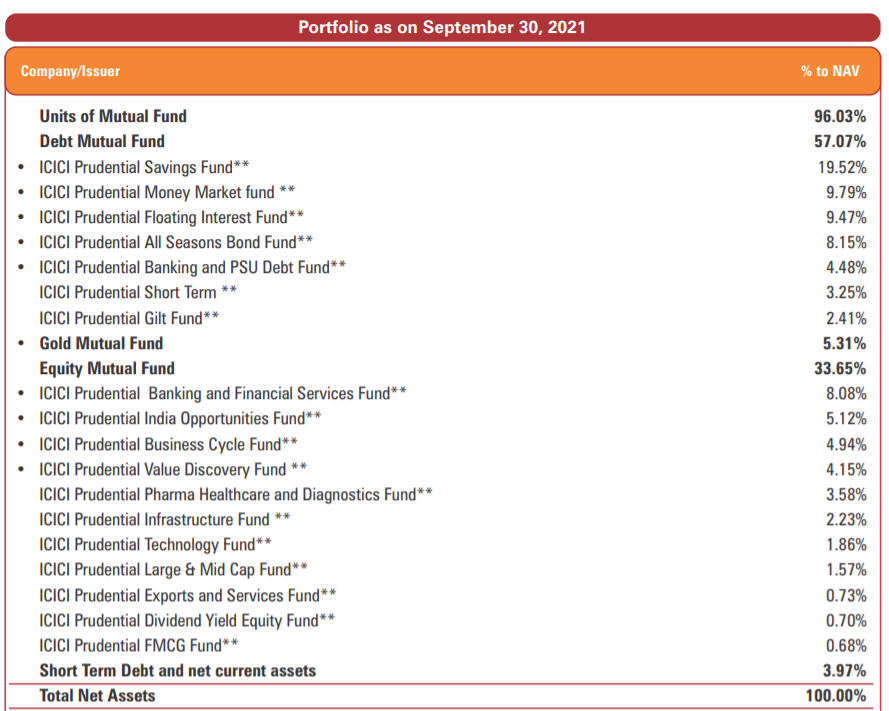When it comes to constructing a mutual fund portfolio, one cannot ignore the importance of Asset Allocation. The recent market scenario once again proved the relevance of asset allocation. It is nothing but dividing the overall portfolio into different unrelated asset classes to manage volatility in the investment portfolio and optimize returns. (Read: How to decide an ideal Asset Allocation mix?)
Broadly, there are four asset classes to allocate your investments into. Equity, Debt, Gold(Commodities), and Real Estate. One way of doing asset allocation is to invest in each of the asset classes separately according to your risk appetite and financial goals. Read my detailed article on asset classes here.
You can invest in equities by directly purchasing the shares or through equity mutual funds, PMS, etc. Similarly, debt investments can be done in the form of small saving schemes, Government Bonds issued by the RBI, corporate bonds, or through debt mutual funds.
Also check: How PMS is different from Mutual Funds?
You can take exposure to gold in the form of Jewellery, physical gold, Gold ETFs, or through Gold mutual funds as well. Investments in real estate can be done physically or in the financial form through Real Estate Investment Trusts (REITs). (Also Read: All you wanted to know about REITs)
But let’s accept the fact that not everyone is an expert or capable of doing this asset allocation on their own. If once done, all may not have the time to monitor and review the allocation on a regular basis and do the rebalancing.
The other way is to invest in some specific hybrid funds, which are designed for this purpose only and have a pre-specified allocation to these asset classes. Read a detailed article on hybrid funds here
In this post, we would be talking about two similar-looking hybrid funds categories- Dynamic Asset Allocation or the Balanced Advantage Funds and Multi-Asset Funds. Although, both the categories on the face of it look similar (from the composition of assets) there is a difference in the investment strategy.
What are Balanced Advantage Funds?
Balanced Advantage Funds or Dynamic Asset Allocation- this category of mutual fund has got a lot of traction of late. Today almost all AMCs have their Balanced Advantage Funds. A recent NFO of SBI Balanced Advantage Fund has seen more than 15,000 crores of inflow from investors. Even new entrants in the AMC business like NJ have launched their first fund in this category. LIC Mutual Fund has also launched the NFO of its BAF.
The main reason for this is the ability of the structure of the fund to manage the downside risk and provide stable returns in times of market volatility with the underlying investment strategy.
As the name suggests, this fund dynamically invests across asset classes. The major allocation of the fund is in equities and bonds. SEBI has also allowed these funds to invest in REITs and InvITs as well. Some funds like- ICICI Balanced Advantage Fund and HDFC BAF have REITs in their portfolio. HDFC BAF has InvIT too. Read a detailed article on Dynamic Asset Allocation Funds here
To maintain the equity taxation of the fund, the minimum equity allocation of these funds should be 65%. But, not all of it necessarily to be open equity. Some portion of the portfolio is hedged with the help of equity derivatives to manage fund volatility.
However, the allocation to these asset classes differs across funds. Each fund house uses its own model to figure out the allocation of open equity, derivatives, and bonds in the fund portfolio based on the market valuations. Of course, they have the flexibility to change the allocation at their own discretion or whenever the model suggests so. Generally, the allocation to equity in these funds lies between 30 to 80%.
Some funds like Edelweiss BAF for instance, follow the momentum approach, i.e. they increase the equity exposure when market valuations are up and vice versa. While some funds like ICICI BAF follow the value/contra approach, i.e. they decrease the equity exposure when market valuations are high and vice versa. (Check the ICICI Balanced Advantage Fund Review here)
This is why you just have to understand the broad structure of the fund but select only after understanding the specific fund features and design.
(Also Read: Balanced Advantage vs Balanced Funds)
I have done a short video around this topic. You may like to watch the same to have a grasp around this subject
What are Multi Asset Funds?
These funds also fall under the hybrid funds’ category. As per SEBI norms, these funds should have exposure to at least three asset classes, namely equity, debt, and gold with a minimum allocation of 10% each. Some funds also provide exposure to a fourth asset class as well. For example, ICICI Multi-Asset Fund and Tata Multi Opportunities invest in commodity derivatives. Axis Triple Advantage Fund and ICICI Multi-Asset Fund also invest in REITs and InvITs, etc.
Similar to the Balanced Advantage Funds, a majority of these funds also maintain the equity exposure to 65% for a tax-efficient structure. Generally, the allocation to equity ranges between 65-80%, and the rest is invested in other asset classes.
Unlike BAF, the allocation to asset classes in these funds remains within the range pre-specified in the investment strategy, and fund managers do not have much flexibility to change the allocation.
Asset Allocator Funds:
To add to the confusion, within the Multi-Asset category, there is another fund type called the Asset Allocator funds. These funds generally come in a fund of funds structure. It means that rather than investing in individual securities, these funds invest in different equity, debt, and gold funds. For example, check the portfolio of ICICI Prudential Asset Allocator Fund:
Like Balanced Advantage funds, you better get into the specific features of such funds to understand if they work in a Strategic allocation approach or have some dynamism into it. Fund of Funds structure will attract the taxation of debt in this.
Since this category does not involve arbitrage in its approach, so many times the equity allocation goes below 65%, so even in actively managed structured the debt taxation applies, for instance, ICICI Asset Allocator Fund follows the Dynamic Asset Allocation strategy and HDFC Asset Allocator Fund follows the Multi-Asset Allocation strategy. So, the taxation of the funds would vary accordingly. (Also Read: Taxation of mutual funds)
Also check: What are Arbitrage Funds?
Balanced Advantage vs. Multi Asset Funds:
Investing in multiple asset classes reduces the overall volatility in the investment portfolio. Plus it also reduces the Biases which come in different market movement cycles, when an investor moves beyond his/her risk tolerance and tries to increase or decrease exposure in specific asset classes. Like it’s happening these days when all investors would like to increase the equity exposure experiencing the recent run-up.
Both these hybrid fund categories are good options to have an allocation to different asset classes in appropriate proportions. But there is a difference in the factor which contributes to lower volatility in both the funds.
In multi-asset funds, the lower volatility comes from the presence of three or more negatively correlated asset classes. It ensures that all asset classes do not rise or fall at the same time. When equity is in a downtrend, debt and gold provide the required stability to the portfolio. (Also Read: How good is Gold as an Investment?)
While in Dynamic Asset Allocation Funds the flexibility to change the allocation between different asset classes according to the investment strategy leads to lower volatility.
However, the multi-asset funds due to the strategic allocation may prove to be more volatile as compared to the Dynamic Asset Allocation Funds due to the over-allocation to equities across all market cycles. Volatility looks fine when you earn high returns. But also frowned upon in the downtrend. (Also Read: 5 best things to do in times of market volatility)
So, all in all, the objectives of both these categories are more or less the same. The choice between the two is a subjective issue. It would largely depend on your risk profile and the level of diversification you want in your portfolio.
If you yourself do not follow any asset allocation approach in your investment portfolio or do not follow it with discipline, then definitely these funds will help you manage the same well.
Multi-asset funds may result in high return with high volatility, But, if you think that you are already allocated to gold in the form of jewellery, etc. and do not want to add more and have your allocation stick to equities and bonds you can go with Balanced Advantage or Dynamic Asset Allocation Funds, which are expected to be low volatile and have resulted well in the past.








 Manikaran Singal is the founder and Chief financial planner at Good Moneying Financial Solutions. He is a CERTIFIED FINANCIAL PLANNER CM and SEBI registered Investment adviser (Regd no. INA 100001620). He’s having 20+ years of experience in financial services space.
Manikaran Singal is the founder and Chief financial planner at Good Moneying Financial Solutions. He is a CERTIFIED FINANCIAL PLANNER CM and SEBI registered Investment adviser (Regd no. INA 100001620). He’s having 20+ years of experience in financial services space.


Excellent analysis by the author. It is important to go deeper while comparing different funds of the same class managed by different fund houses>: as pointed here the differences between the 2 BAFs from Edelweiss & ICICI Pru are significant.
Thanks for appreciating, Mr.Nadoor.
Volatility has been my concern right from the start of my investing journey and hence I have always chosen a simple balanced advantage fund instead of a multi-asset fund. The return difference is also not that big between these and hence I prefer balanced over multi-aset.